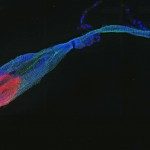Link to Pubmed [PMID] – 11204924
Pathol. Biol. 2000 Dec;48(10):921-32
Spoligotyping (for ‘spacer-oligonucleotide-typing’), a rapid method for genotyping of Mycobacterium tuberculosis complex using the principle of reverse hybridization, is based on the structure of the direct repeat (DR) locus. The DR locus is made up of a variable number of 36 bp DR repeats that are separated by unique inter-DR sequences of 35 to 41 bp. Fast and highly discriminatory, spoligotyping is an useful alternative to the IS6110-RFLP reference method for molecular typing of M. tuberculosis, in particular for isolates possessing five or few copies of IS6110. In this paper, we review the state of the art of spoligotyping through its main current applications. After a brief introduction to the principle of the technique and its description, we successively review recently published results concerning the molecular epidemiology of tuberculosis in humans and cattle, and discuss the main genotyping strategies currently in use to fingerprint the M. tuberculosis complex organisms. We also describe the recent applications of spoligotyping to study ancient DNA and report on recent developments of this technique to study the biodiversity of the M. tuberculosis complex, its contribution towards improved taxonomy and phylogenetics of the M. tuberculosis complex. Last but not least, potential applications of spoligotyping to study DNA recombination mechanisms are also discussed.

